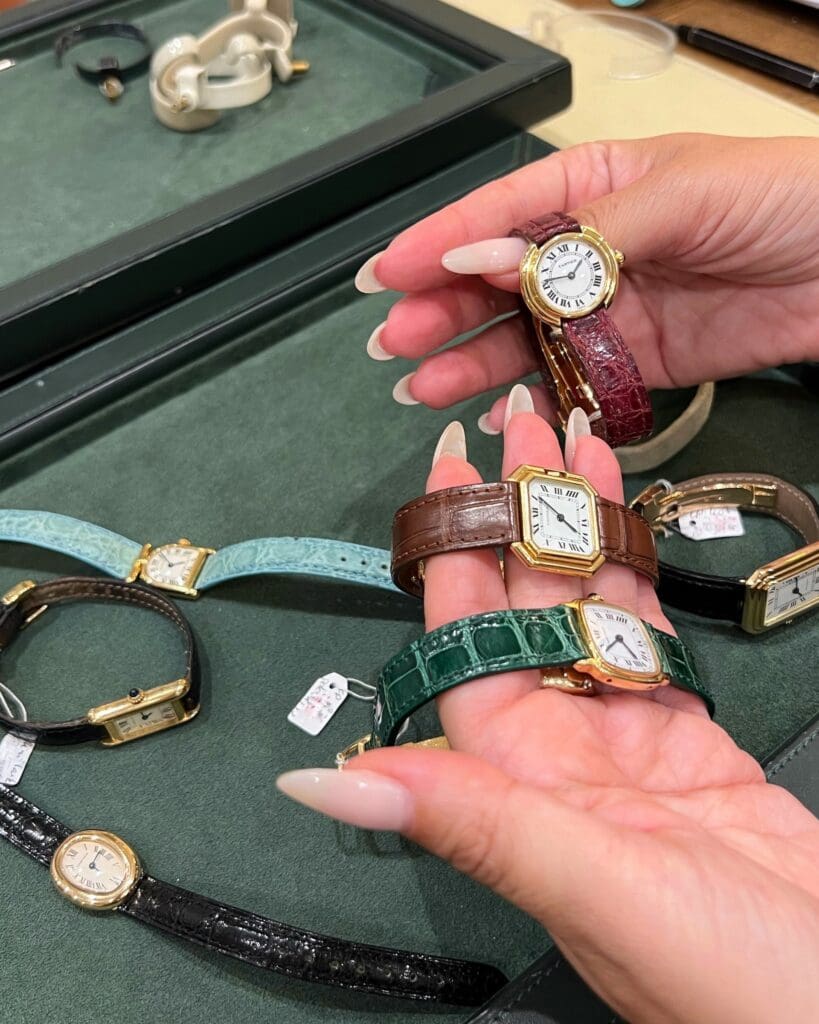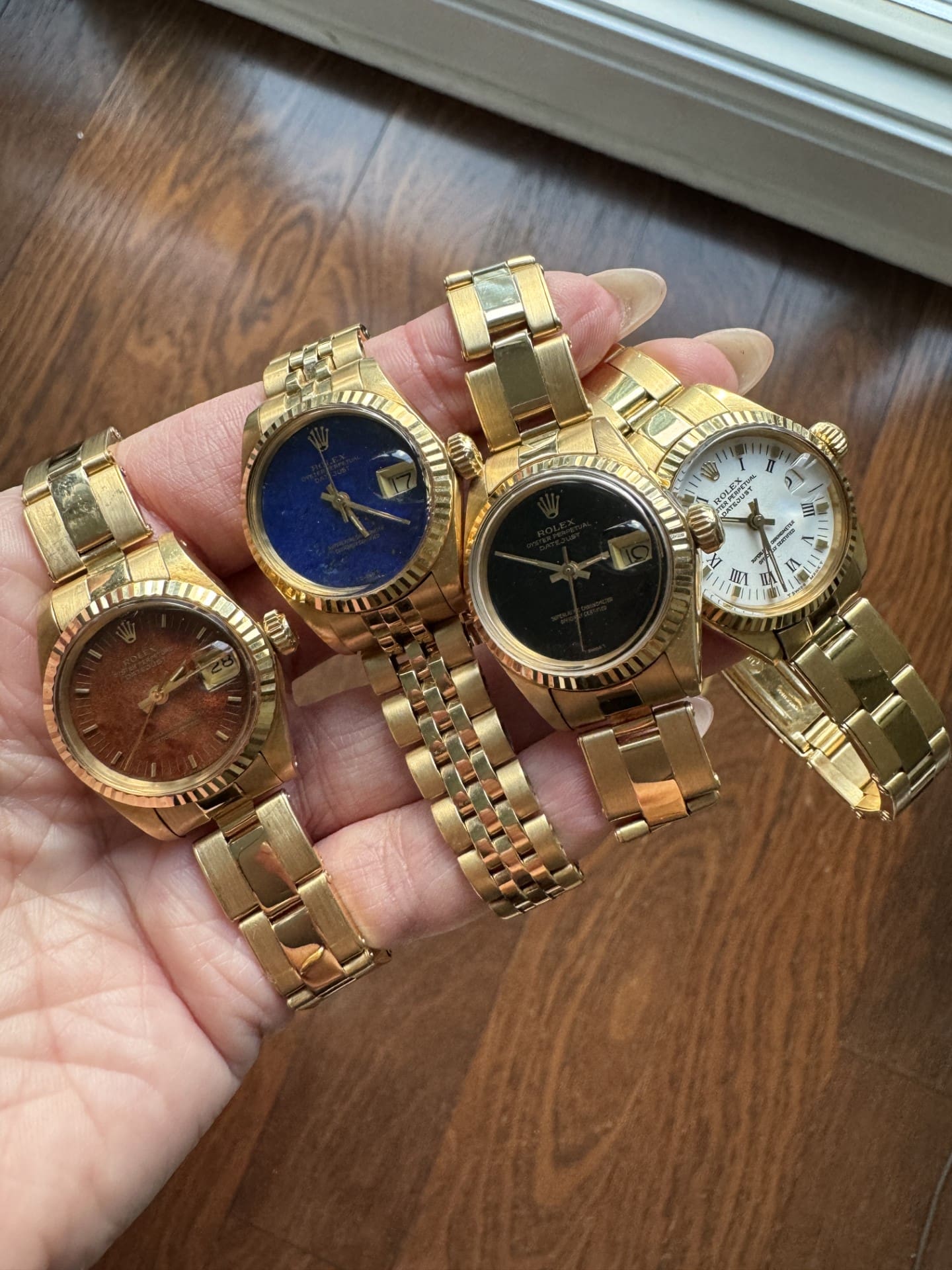Noah Lehava’s social media serves up a virtual treasure trove of “juicy” gemstones, dazzling diamonds and glistening gold. Through her Instagram account, the Toronto-based entrepreneur shares a curated selection of vintage fine jewelry and timepieces for the consideration of her more than 17,000-plus followers. The vintage luxury watches made available on the feed—including an 18-karat-gold-and-stainless-steel Rolex Oyster Perpetual Date from 1974 and a slim-lined, 18-karat-gold Cartier Tank Americaine Mini complete with its original black leather strap—are among some of the most covetable designs in the watch world today.

“It’s an absolute obsession this year,” Lehava says of the growing interest in vintage wrist watches among her online clientele. “I love that there’s a huge resurgence and appreciation for timepieces, especially by women.” Her curated selection of finds has proved so popular, select pieces have also been picked up by Holt Renfrew to sell as part of its sustainable product offering.
In addition to representing a wearable, working collectible—made all the more valuable thanks to precious materials and venerated brand names—Lehava says the allure of vintage luxury timepieces lies, for both collectors and fashion fans, in the unique adornment aspect that a throwback timepiece presents.
“Vintage timepieces from the ’50s up to the ’70s and early ’80s were designed as pieces of jewelry; beautiful stone dials, interesting shapes, dainty diamond bracelets,” she says. “I think, since then, watch designs took a more utilitarian approach and became more about function—think: smart watches—over aesthetic. Consumer habits are shifting to not only appreciate beautiful craftsmanship but also to make good investments. And fine jewelry and watches have proven to be both.”
Under the umbrella of an industry that seems reticent regarding ways to incorporate vintage pieces into its business model, watch brands are at the forefront of reselling in the luxury world. Swiss watch-makers like Omega, Zenith and Longines are just a few of the companies that offer vintage timepieces alongside new assortments.
“We have seen in recent years that there is a huge demand for vintage watches among young people, and our range of heritage-inspired watches is very popular today,” Matthias Breschan, CEO of Longines, says. “The most important thing for these people is that the relationship to heritage and history is authentic and that you are not launching a product by making up a story.”
Made available through its Collector’s Corner, Longines offers a small selection of rare timepieces such as a rose-gold Chronograph and a Longines Flyback Diver dating back into the 1950s and 1960s. Each preloved timepiece has been “serviced and revised” for resale by the Longines Heritage workshop.
Wearing a piece of the past is what originally drew Lehava, who was formerly an editor at Elle Canada and Coveteur, to start her vintage reselling business. “I’m a very sentimental person and to me, jewelry always had a magical way of holding and passing down stories. It also happens to be really beautiful,” she says. “I first began collecting pieces myself, and what better way to fuel your own obsession than to make it your full-time job?”
For Lehava, sourcing the unique jewelry and watches has required building a network through “a lot of schmoozing and curiosity” that has opened a door into the world of rare collectibles. “I met some of my best dealers and sources by asking around and having the guts to walk into places that may not look too promising from the outside. I also love to travel and use every trip to search out more unique vintage finds at antique stores, markets, and make new connections with other dealers.”
But for in-house teams at watchmakers like Rado, the hunt for a piece of history isn’t quite so difficult. “We do not have to look at our competition for inspiration, we can draw it from our vintage pieces,” Adrian Bosshard, CEO of Rado, explains. “Rado was founded in 1917 and is therefore exceptionally fortunate to have a very rich company heritage. Our museum vault is full of unique timepieces that have a story to tell.”
That rich catalogue of past creations offers both a deep dive into the company’s history with its iconic watch models—such as the Anatom, the Captain Cook and the DiaStar—as much as it does to its present and future. Due to the popularity of its most recognizable watch designs, Rado has relaunched some of its historic models, like the square-shaped Rado Anatom, first released in 1983, in order to appeal to those watch consumers who are looking to wear a piece of the past in the present.
“We are in the lucky position to offer our customers vintage-inspired timepieces that feature the most modern watchmaking technology and materials—the best of both worlds,” Bosshard says of the old-meets-new approach.
As watch brands look to the future with aspects of design that include anti-magnetism and digital integrations, insiders expect to see an interest in historical creations and vintage pieces hold firm. “Watches are one of the most sustainable products there is,” Breschan says. “Nobody buys a watch to throw it away after six or 12 months. You buy it for your whole life, or even for the next generation. And there’s a good chance that the watch you buy today will outlive you.” —Aleesha Harris

Be the first to comment